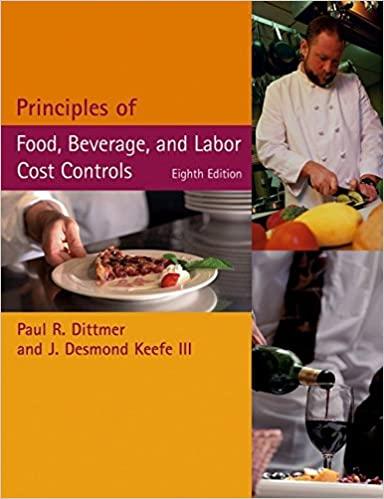Question
Three entrepreneurs were looking to start a new brewpub near Sacramento, California, called Roseville Brewing Company (RBC). Brewpubs provide two products to customersfood from the
Three entrepreneurs were looking to start a new brewpub near Sacramento, California, called Roseville Brewing Company (RBC). Brewpubs provide two products to customersfood from the restaurant segment and freshly brewed beer from the beer production segment. Both segments are typically in the same building, which allows customers to see the beer-brewing process.
After months of research, the owners created a financial model that showed the following projections for the first year of operations.
| Sales | ||
| Beer sales | $ | 856,800 |
| Food sales | 979,200 | |
| Other sales | 204,000 | |
| Total sales | $ | 2,040,000 |
| Less cost of sales | 475,320 | |
| Gross margin | $ | 1,564,680 |
| Less marketing and administrative expenses | 1,138,800 | |
| Operating profit | $ | 425,880 |
In the process of pursuing capital through private investors and financial institutions, RBC was approached with several questions. The following represents a sample of the more common questions asked:
- What is the break-even point?
- What sales dollars will be required to make $230,000? To make $540,000?
- Is the product mix reasonable? (Beer tends to have a higher contribution margin ratio than food, and therefore product mix assumptions are critical to profit projections.)
- What happens to operating profit if the product mix shifts?
- How will changes in price affect operating profit?
- How much does a pint of beer cost to produce?
It became clear to the owners of RBC that the initial financial model was not adequate for answering these types of questions. After further research, RBC created another financial model that provided the following information for the first year of operations.
| Sales | |||||
| Beer sales (42% of total sales) | $ | 856,800 | |||
| Food sales (48% of total sales) | 979,200 | ||||
| Other sales (10% of total sales) | 204,000 | ||||
| Total sales | $ | 2,040,000 | |||
| Variable Costs | |||||
| Beer (12% of beer sales) | $ | 102,816 | |||
| Food (32% of food sales) | 313,344 | ||||
| Other (29% of other sales) | 59,160 | ||||
| Wages of employees (22% of sales) | 448,800 | ||||
| Supplies (3% of sales) | 61,200 | ||||
| Utilities (5% of sales) | 102,000 | ||||
| Other: credit card, misc. (2% of sales) | 40,800 | ||||
| Total variable costs | $ | 1,128,120 | |||
| Contribution margin | $ | 911,880 | |||
| Fixed Costs | |||||
| Salaries: manager, chef, brewer | $ | 139,000 | |||
| Maintenance | 27,000 | ||||
| Advertising | 14,000 | ||||
| Other: cleaning, menus, misc | 36,000 | ||||
| Insurance and accounting | 39,000 | ||||
| Property taxes | 19,000 | ||||
| Depreciation | 86,000 | ||||
| Debt service (interest on debt) | 126,000 | ||||
| Total fixed costs | $ | 486,000 | |||
| Operating profit | $ | 425,880 | |||
Required:
Perform a sensitivity analysis by answering the following questions:
a. What is the break-even point in sales dollars for RBC?
b. What is the margin of safety for RBC?
c. What sales dollars would be required to achieve an operating profit of $230,000? $540,000?
Step by Step Solution
There are 3 Steps involved in it
Step: 1

Get Instant Access to Expert-Tailored Solutions
See step-by-step solutions with expert insights and AI powered tools for academic success
Step: 2

Step: 3

Ace Your Homework with AI
Get the answers you need in no time with our AI-driven, step-by-step assistance
Get Started


